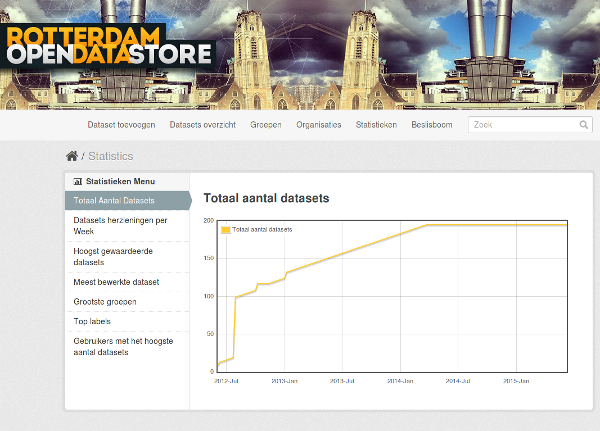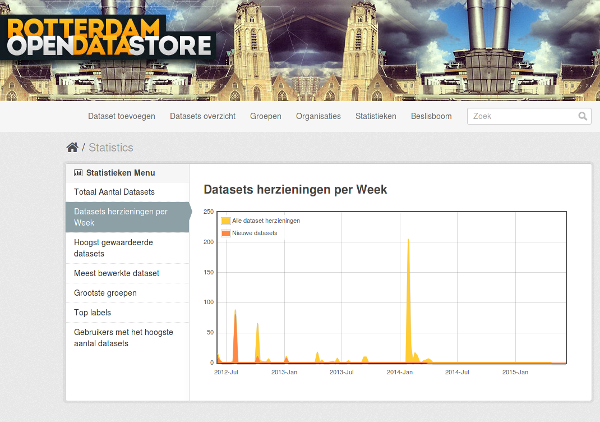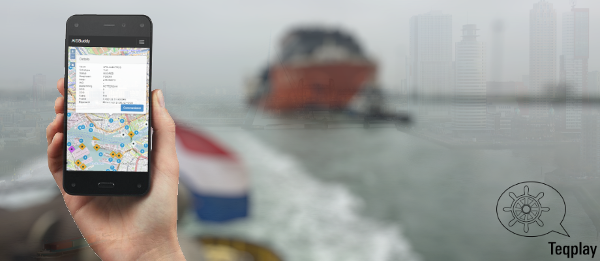The Rotterdam Haven Lab brings together open data, technology and cooperation in an economic context. There still are many inefficiencies left in the port's transport and logistics. The solution is to connect and share everything.
The Port of Rotterdam Authority is developing a vision on the role and importance of data in the port. The Authority wants to make as much data as possible freely available.
It is hard to develop a vision or strategy until you really understand what open data means to your industry. So we create as many apps and pilots as we can to find out where the value is and what the role of the Authority should be. There is a lot of opportunity in the port, so we expect big disruptors to enter our industry in these coming years.
Policy Context
Leon Gommans is a leading figure in the development of open data in both the city and the port of Rotterdam. Now co-owner of PlaySpace and Teqplay, he is a firm believer in open. I share everything as a matter of principle. My passion for open data started when I was working at the department for Communication, Media and Information Technology at the Hogeschool Rotterdam and we needed real data for one of the projects we were running.
Rotterdam Open Data
The Haven Lab has its roots in the Rotterdam Open Data project. This portal is built on the well-known CKAN open data server software and currently provides 181 datasets from nine organisations. Some examples are:
- several datasets on environmental measurements by DCMR, the environmental protection agency for local and regional authorities in the Rijnmond region;
- all sorts of road network and road system information from the City of Rotterdam;
- data on cultural, educational, medical, and recreational institutions and facilities;
- social and environmental security data;
- geographical and geospatial data;
- data on public transport from by RET, the regional operator.
The City of Rotterdam introduced an open data policy in its innovation agenda of 2011, linking open data to economic opportunities and making the city an early adopter. In cooperation with the Hogeschool Rotterdam and Gommans, all sorts of app development projects were initiated as part of the 'City Lab', and several conferences were organised. That was also the start of the Rotterdam Open Data portal.
Responsibilities
The political and organisational responsibility for the municipal open data project lies with the Vice Mayor of Employment and Economic Affairs and the Vice Mayor for Sustainability, Mobility, and the Port. In its first year the project had a full-time Open Data Manager, reporting to the municipal CIO, to spread the word, collect datasets and make these available online.
According to a 2014 open data evaluation report written for the Dutch Ministry of the Interior, the initiative now seems to have lost momentum, as most of the datasets are no longer being updated.
The CIO of the City of Rotterdam, Mark Vermeer, recently complained that the city has not yet seen any money from the datasets that were published. Obviously, students starting their careers cannot be expected to maintain the apps they created as school projects. Companies will only invest if they can actually put an app to use. And the City is not willing to make a budget available to revive the Open Data project, especially since last year it killed open data as an independent innovation theme. It appears that the further development of open data in Rotterdam will depend on the Port Authority, Teqplay and other innovative companies.


Costs
The authors of the evaluation report set the initial costs for the set-up and the Open Data Manager at 20,000 and 50,000 euro, respectively, with annual operating costs of 45,000 euro. In 2011 and 2012 most of the budget was provided by the Hogeschool Rotterdam. Currently, the CIO Office of the City covers the operating costs of the portal.
For two years Gommans was able to spend half of his time at the Hogeschool Rotterdam working on open data. His assignment was to connect the knowledge and structure within the school to the outside world. Open data was his way to accomplish this mission. Since the projects were part of the practical education curriculum, the Hogeschool invested 100,000 euro from its regular budget, and an additional 150,000 to get open data started. All in all, 300,000 euro was invested in these projects over a period of three years. Companies that Gommans was able to interest in his projects contributed another 400,000 euro, mostly in the form of hours worked.
Haven Lab
While Rotterdam Open Data focusses on the urban domain,
Gommans explains, the Haven Lab brings together open data, technology and cooperation in an economic context. There still are so many inefficiencies left in transport and logistics. For example, at this moment 55 percent of what we transport is just air. In both directions, that is, so it actually is an information problem rather than an asymmetry. Half of the costs in the port relate to coordination and waiting. For example, at any moment, several hundred trucks are waiting for a load.
In a 2011 advisory report, the Logistics team of the Dutch 'Topsector' innovation programme set a goal of increasing the loading level from 45 to 65 percent by 2020.
The solution, of course, is to connect and share everything. This is, however, easier said than done. The Port of Rotterdam Authority has developed a vision of the role and importance of data in the port. They want to make as much data as possible freely available. Currently, they are investigating the implications of this strategy: What are the legal issues with regard to privacy and security? What fears do people have? And who is responsible for faulty information?
Description of target users and groups
The Authority earns its money leasing docks and land,
Gommans continues. If their tenants are insufficiently organised and inefficient, the port loses its competitive power and attractiveness. So they work continuously on a high-efficiency ecosystem. The new 'Maasvlakte 2' will extend the port by 20 percent in acreage and one-third in capacity. This expansion now has to be made profitable.
The main question, of course, is how to move the ecosystem in this direction. Each business has its own interests. Some companies make money on empty containers. Others may not have an interest in price transparency. The logistics business is a tough world; it's all about high volumes and low margins. At the same time, the Authority is not a player in this market; it can only impose restrictions related to security, customs and such. So they tell the businesses to make more data available.
Description of the way to implement the initiative
According to Gommans, the Automatic Identification System (AIS), which lets the port's Vessel Traffic Service (VTS) identify and locate ships, can play an important role here. Each ship has a VHF transponder that broadcasts the vessel's identity (MMSI), position, course, and speed. An AIS receiver can be bought for a few hundred bucks,
says Gommans, so this data is already being crowdsourced and published by an online community of enthusiasts. The AIS information provides insight into the flow of ships.
The value of the AIS data can be further increased by combining and aggregating it with other information. For example, there are companies serving the oil traders with data on the location of tankers and transport capacity. That information is currently not publicly available, because the location of oil determines its price. Illustrating this is the fact that the cargo of a tanker is sold fifteen times on average during its voyage.
At the same time, an empty tanker wants the whole world to know its location and availability.
Other applications may provide insight into the location of hazardous substances and the amount of traffic and other risks in the area.
Technology solution
AIS Buddy
The AIS Buddy app provides a good example of what can be done by aggregating AIS data with other information. Using the unique MMSI as a key, this app allows inland skippers — carrying cargo onward via rivers and canals on their barges — to make their contact data available to others. Traditionally, radio was the only way vessels could be contacted. Now they can contact others by mobile phone and e-mail — by simply clicking on the map — and be contacted in the same way. Authorities and businesses can provide location-based services, such as SMS alerts for speed limits, obstructions and accidents.
By relaying all mail and mobile traffic through the server system, the privacy of the participants is protected. In addition, the app provides its own notification service. According to Gommans, considerations like this are important in getting the new technology accepted by the skippers. These people are deeply attached to their freedom. They refuse to be managed, or they are afraid that information about their location can be abused by others.
So we emphasize the value of this app. An inland skipper who arrives too late may find his dock engaged, forcing him to wait. However, each hour in port will cost him a lot of money. So instead of having him run full steam to a dock that is no longer available, we may come up with alternatives.
AIS Buddy was thought up as 'Call me on AIS' at the second World Port Hackathon in 2014, where it won the first prize. In December, a three-month pilot was started. The next step is to gradually add new services. The people who created AIS Buddy are now turning their project into a company.

Water apps
The annual World Port Hackathon — part of the Wereldhavendagen (World Port Days) — is a joint initiative of the Port of Rotterdam Authority and Teqplay, one of Gommans' technology playgrounds.
Apps that were built during the first World Port Hackathon in 2013 [2] include a timeline application showing sea-side logistics. When a ship enters the port, all sorts of logistic processes are launched,
Gommans explains. Using the AIS system, we can deduce the vessel's current status from its meetings with various service vessels: first the pilot boat, then the tug, and finally the boatmen responsible for mooring and unmooring. Other ship-to-ship meetings relate to wastewater disposal, bunkering, and transshipment. All this information can be used to calculate an Estimated Time of Arrival (ETA) for the inland shippers waiting for their containers. But this information can also be used to optimise the process itself.

Last year, Teqplay participated in the National App Award, organised by the Dutch Ministry of Economic Affairs, and won the first prize in the Water category. Their 'Ligplaats Vrij' (Berth Available?) app — "the parking space app for the water" — uses AIS information to show skippers the availability of berths in the port of Rotterdam. Instead of navigating from one lay-by to another in search of a free spot, skippers now can simply find one on their computer or phone. They can even receive notifications when their preferred berth becomes available.
Proofs of concept
We have been working on the Haven Open Data project for two and a half years now,
Gommans concludes. The Port of Rotterdam Authority recognises its importance and is working on an open data strategy. There is no use in developing a solution that covers it all, because the environment is changing too fast and we have to overcome quite some resistance. So we started small and are extending and building on what we already have. Our apps aim to show possibilities and provide proofs of concept.
Main results, benefits and impacts
Open data vision
Our first open data vision dates from two years ago,
says Mare Straetmans, Innovation Program Manager at the Port of Rotterdam, and it should be renewed. Back then, no-one over here thought in terms of the Internet of Things, big data and open data. We did, however, have an air quality monitoring system that now would be considered part of this new world.
Two years ago, we put open data on the corporate agenda. I firmly believe that this is by far the most important development in our industry. Over the next ten years it will have the largest impact on the port with regard to efficiency, safety, optimisation, and our competitiveness.
At this moment, management and some other key people in our company are aware of open data and its importance. Our current strategy is to make as much information as we can available as open data and to stimulate people to put it to use.
Return on investment
Make it happen
Our main issue now is how to make it happen,
Straetmans continues. It is hard to develop a vision or strategy until you really understand what open data means to your industry. So we create as many apps and pilots as we can to find out where the value is and what the role of the Authority should be. We work, for example, on apps showing the draughts and departure times of ships. So instead of creating another portal, we now provide apps and data.
We have invested 100 million euro in Portbase [a logistics information delivery and exchange platform for all the Dutch ports]. That data still has to be opened up. The port exchanges huge amounts of data, but in a traditional way. We need to redefine ourselves in terms of big data and open data. And that is not an easy task because of the structure and complexity of our ecosystem — there are thousands of parties involved — and the fact that a lot of companies make money from disinformation and a lack of transparency.
Lessons learnt
Disruptive innovation
Two years ago, we started the World Port Hackathon,
says Straetmans. Now this event is organised by Gommans, who is far better than we are in achieving quick and practical results. We also did a Google Glass project together.
All these experiments will take another couple of years during which we will experience what open data is. We currently produce one and a half, maybe two apps a year. It would be great if that number increased to twenty or forty apps a year. There is a lot at stake, so we need to speed up.
I am a firm believer in Uber-like parties that turn your world upside down. You need disruptors like these to initiate change. You cannot expect Hilton to invent a business like Airbnb. That is why we also invest in start-ups. There is a lot of opportunity in the port, so we expect big disruptors to enter our industry in these coming years.

